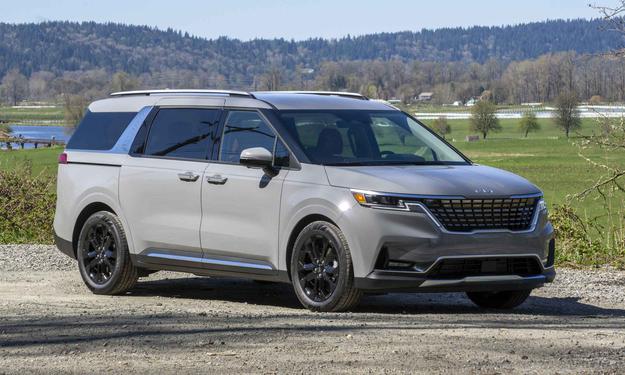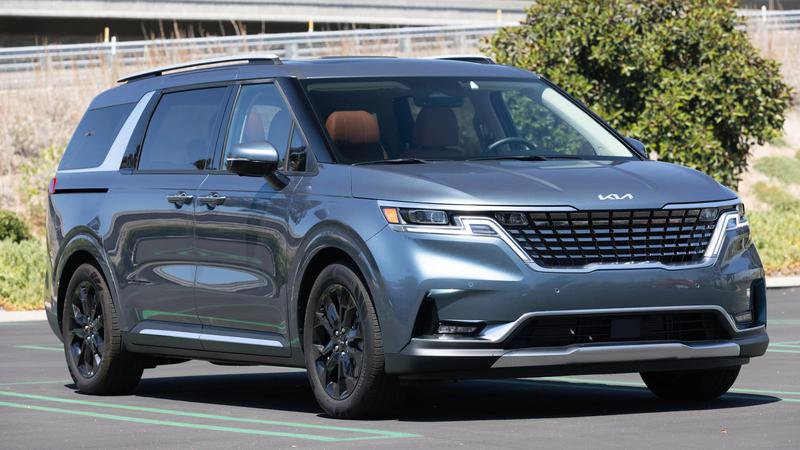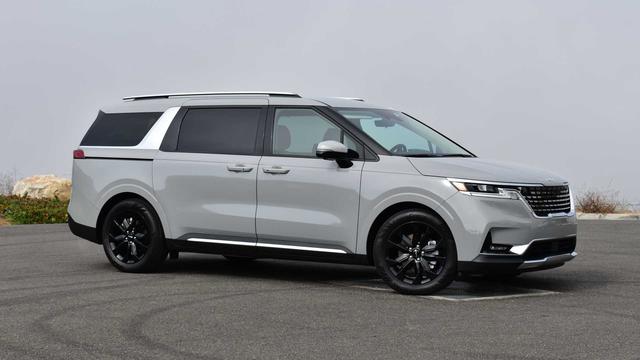The 2022 Toyota Sienna has plenty of features that can compete with the sea of SUVs out there, and its hybrid powertrain offers truly impressive fuel economy.
Toyota’s 2022 Sienna has lots to like. For starters, this capable minivan seats up to eight people and offers plenty of storage and cargo space. It’s only available with a hybrid power package, but that means you get great gas mileage in this capable hauler. And given the recent rising gas prices, that’s a big plus in our book.
In addition to the three rows of seating and that economical hybrid engine that destroys the competition with an estimated 36 mpg in the city, the Sienna sports some styling cues that won’t make you embarrassed to park this minivan at the front of the lot.
In fact, for buyers willing to give the Sienna a second look, this minivan might just snag a few skeptical drivers once they rank it against the other limited offerings in the minivan segment.
The 2022 Toyota Sienna is available in six models: the base LE, a Woodland edition with all-wheel drive, three other upgraded models, and the range-topping Platinum. Depending on your use case, the Sienna can stick to the pavement or take you on your next car camping adventure with ease.
Prices range from under $35,000 to over $51,000 depending on the configuration. We recently tested the base LE and were impressed to find that even this basic minivan was still packed with the right stuff.
Toyota realized that buying a minivan might not be the most brag-worthy vehicle purchase, so it crafted a more aggressive look for the 2022 Sienna.
Say goodbye to the flat sliding door panels that make most minivans look like dull cargo haulers. The added flares and creases give the Sienna some rugged style without losing the aerodynamics of this big-box hauler.
Ever since carmakers started offering SUVs with third-row seating, the need for large-capacity minivans has diminished. But let’s face it, in many of these SUVs the third row is not the most spacious and the cargo space behind the third row is minimal. Not so with the Sienna.
The split-row third-row bench seat is designed to easily tuck down into the floor. When the seat is up, those deep floor wells can hold a ton of luggage and essentials. I put this to the test on a recent trip to Northern California. We took the base model Sienna LE out for a weekend with four adults, two kids in car seats, and enough luggage to overwhelm any bell captain.
If you are strictly looking for cargo space, fold down the rear seats and slide the center seats all the way forward for loads of room. The one drawback to the Sienna is that the center seats are not removable.
Toyota did, however, craftily mount them on long sliding tracks so you can move the seats all the way up against the front two cabin chairs to maximize the floor space. But the permanent seats do limit your cargo options.
Toyota offers optional captain’s chairs for the second row in the Sienna, which reduces the seating capacity to seven. The standard bench seat gives you room for eight.
If you opt for the standard bench seating for the second row, you do get some added convenient features. The narrow center seat can easily be removed from the bench seat, allowing the two outer seats to act as quasi-captain’s chairs. This also gives you easy access to the third row.
Two additional cup holders on the floor give you (and your passengers) a total of 18 cup and bottle holders. If you prefer, either side seat also easily folds and slides forward to allow similar access to the third row.
The Sienna interior features a pretty standard Toyota utilitarian look. Two instrument gauges flank a customizable 4.2-inch center info screen. A larger 9-inch screen in the center of the dash controls navigation and music and displays vehicle information. The Sienna is compatible with Apple CarPlay, Amazon Alexa, and Android Auto.
The sound system is basic with six to eight speakers but is sufficient to drown out the road noise. Six USB charge ports should keep everyone’s electronics charged up and ready to play for those long family road trips.
Toyota only offers the Sienna with one basic hybrid engine. But what a thrifty package it is. The gas engine is a 2.5L 4-cylinder that makes 245 net hybrid system horsepower. The base models come with two electric motors for the front wheels, while the upgraded models also include one rear motor.
The base engine gets an EPA estimated 36 mpg city and highway, while the upgraded minivans are rated at 36 city and 35 highway. In our testing, we consistently saw mileage in the upper 30s and once reached nearly 45 mpg, though that was not the norm.
The minivan is full of juxtaposition. It’s possibly the most versatile and practical vehicle on the market. Yet it’s also the most stigmatized and unloved by Americans these days. Read more…
Despite the bulk of the minivan and hauling a full load of passengers, the Sienna was still able to easily reach highway cruising speeds and merge into traffic. It won’t dazzle anybody leaving a red light, but it sure looks pretty at the gas pump.
That gas tank holds 18 gallons so you could easily reach over 600 miles of range on one tank — great for long road trips or getting away from civilization for some weekend R&R. Most of the other minivans get a truly disappointing 19-17 mpg in the city.
Even the Chrysler Pacifica hybrid version only gets 30 mpg for combined city/highway use and starts at over $56,000. The EPA estimates that the average fuel cost for the competition will be at least $1,000 more each year if gas averages $4.10 a gallon. Let that sink in for a minute!
The Toyota engineers use an electronically controlled CVT (Continuously Variable Transmission) in the Sienna. This means you won’t have to deal with awkward downshifting or upshifting when driving in hilly terrain as the transmission seeks the right gear.
Instead, with a CVT, the transmission smoothly glides to the right ratio. And I found the Sienna handled the hills of San Francisco and Yosemite without breaking a sweat — or snapping a neck.
Toyota measures the cargo space behind that third seat at 33.5 cubic feet. Drop down the third row, and that space expands to 75.2 cubic feet. Slam the second row of seats forward with the front seat as far forward as it will go, and you have just over 100 cubic feet of space to work with.
Whether you’re hauling a full load of gear or catching a few winks at a campsite, the rear cargo space should give you plenty of room to work with.
If that is not enough room, add a trailer hitch, and the Sienna can tow up to 3,500 pounds. Or throw a rack on the hitch or roof and you’ll be set for hauling all your toys, too.
The 2022 Toyota Sienna minivan comes with a set of features that become more and more useful as you use them. The push-button start means never having to dig the keys out of your pocket or purse. The side doors are power sliding with a one-touch sensor in the door handle — very helpful when lugging a child or two around.
The Sienna is also packed with the latest safety measures found in Toyota’s Safety Sense 2.0. Even the base model included a pre-collision system with pedestrian detection, lane departure alerts, lane tracing assist, and road sign assist.
It also has a blind-spot monitor, rear cross-traffic alerts, automatic high beams, and adaptive cruise control. Throw in 10 airbags and no wonder the Insurance Institute for Highway Safety awarded it a Top Safety Pick+.
If you’re sold on the concept of a minivan, your choices are limited. Out of Detroit, you can only get the Chrysler Pacifica. The imports competition includes the Kia Carnival and the Honda Odyssey. And when compared to these options, the Sienna’s class-winning gas mileage is a compelling selling point alone.
If you want a minivan to haul your crew and cargo, the 2022 Toyota Sienna is an attractive option with tons of space and is as versatile as many SUVs. Toyota advertises the Sienna as more than enough, and we would agree with that assessment. Check it out for yourself.
Volkswagen is finally rolling out the long-awaited replacement for its iconic Microbus — though the new ID. Buzz won’t make it to the U.S. for another year. Read more…



